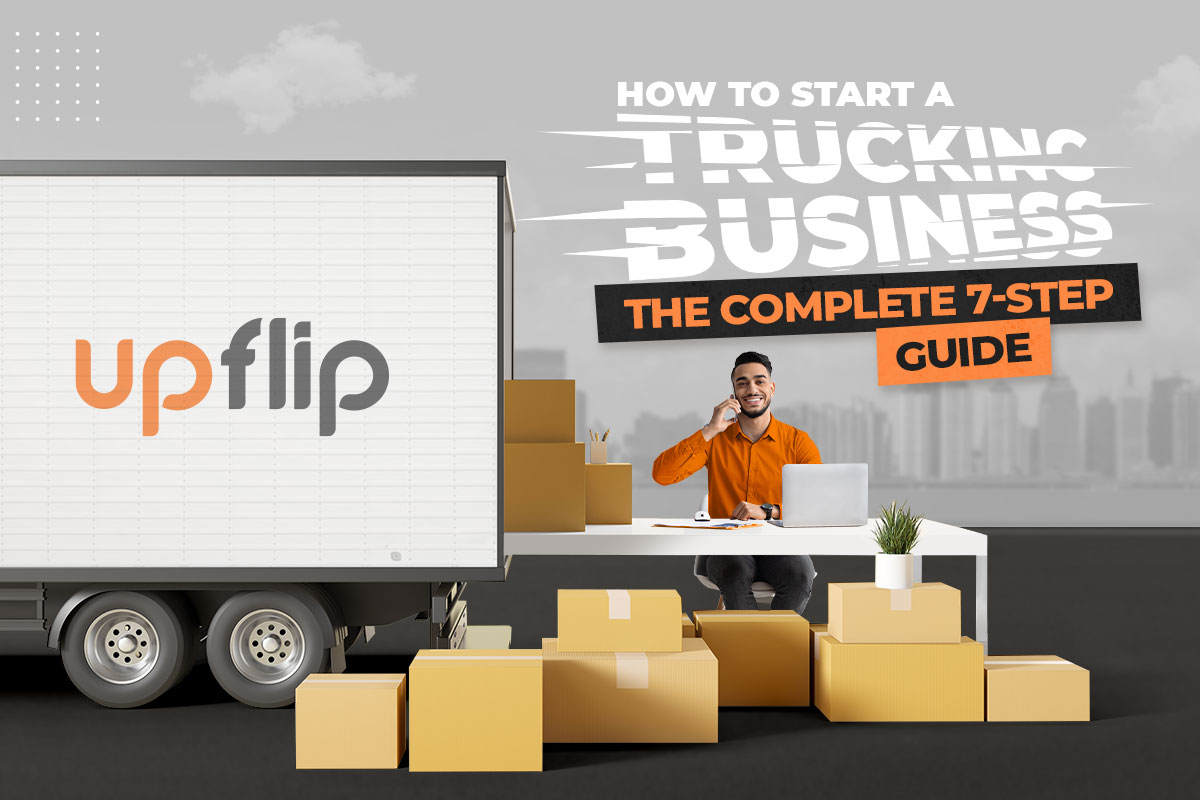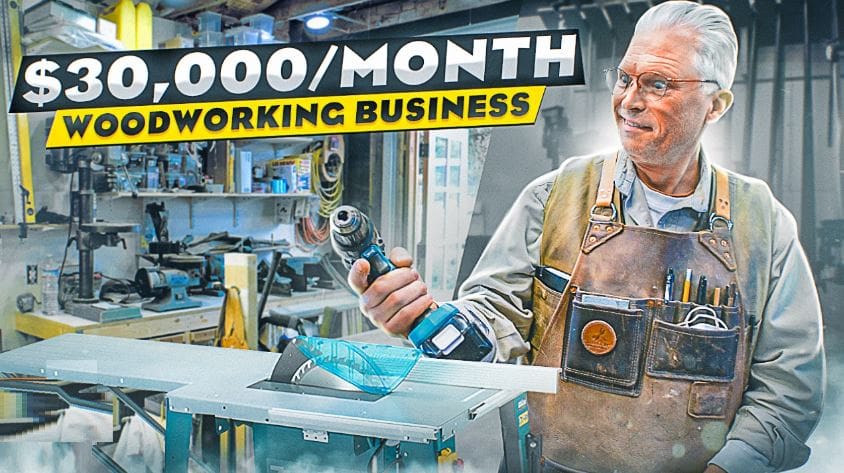How to Start a Trucking Company in 7 Steps
Want to get into one of the fastest-growing industries in the country? The trucking business isn’t known for its high profits, but that changes when you start hauling 80,000 pounds per truck. That’s right! We’ll learn how to start a trucking business with expert advice from a trucking company.
Mikael Sant, the founder of Sant Lines, is ahead of the game. He started Sant Lines in May of 2021 at the age of 19. The trucking company made over $159,000 in revenue in the first six months. That’s more than many owner-operators make in a year. He has grown to four trucks, expects to have 100 in seven years, and is working to be a dominant force in the industry.
We’ve outlined the process to start a trucking company in just 7 steps. Click any of the links below to jump ahead.
Quick Warning
Before you even consider operating a trucking company, you should:
- Get a DMV printout: If you have a DUI, vehicular manslaughter, or other charges, you will not be able to get a job or insurance.
- Have no convictions for drugs, felonies, violent crimes, or fraud: It will be difficult or impossible to qualify for a job, insurance, or getting an authority.
- Check insurance price:. Mikael spends $45,000 per year for his insurance because he is a new CDL driver.
- Understand Finances: Every load you accept will have costs that impact it. Real simply, if you can’t multiply and calculate percentages, you are likely to struggle immensely. You need to be able to calculate the costs based on mileage and the weight of load. To make good money, you’ll need each load to be at least three times the cost.
How to Start a Trucking Business Case Study: Sant Lines
Mikael is a serial entrepreneur. He owns:
- Sant Lines
- Sant Logistics & Freight LLC
- Rettig & Sant LLC
- SANT Co
- Squeaky Clean Pressure Washing & Paint LLC
- VESTALO LLC
Check out our interview with him below:
You can write your own success story in trucking by following Mikael’s advice with these seven steps.
Step 1. Know the Trucking Business
Most of us are familiar with trucking on some level, whether it’s seeing big rigs on the road or utilizing local moving companies. Behind the products we receive from those giant trucks, plenty of government regulations ensure every trucking company delivers products safely.
If you haven’t worked in a trucking company, it’s important to get some industry experience and specific licenses. You might want to work with a moving company to learn about the industry.
How do truckers make money?
Very simply, truckers make money based on miles and weight as they transport products. A trucking company operates under one of four main NAICS codes:
- 48412 Long Distance Trucking
- 48411 Local Freight Trucking
- 48422 Local Specialized Freight Trucking
- 49222 Courier and Local Deliver Services
Trucking businesses charge different amounts based on what they are hauling and where they are hauling it. I combined the IBIS World statistics for the four sectors and found that the industry makes $557.2 billion in annual revenue and $33.2 billion in profit. Check out the rest of my findings below:
| NAICS Code | 48411 | 48412 | 48422 | 49222 | Combined |
| Type of Trucking | Local Freight | Long Distance Freight | Local Specialized Freight | Couriers and Delivery | 4 Major NAICS Codes |
| Revenue (billions) | $86.60 | $262.90 | $56.10 | $151.60 | $557.20 |
| Expected CAGR (compound annual growth rate) | 0.80% | 1.20% | 1.90% | 3.60% | 1.90% |
| Profit (billions) | $5.70 | $13.70 | $3.60 | $10.20 | $33.20 |
| Profit Margin | 6.60% | 5.20% | 6.40% | 6.70% | 5.96% |
| Number of Businesses | 307,000 | 570,000 | 65,000 | 416,000 | 1,358,000 |
| Expected Businesses CAGR | 4.30% | 4.20% | 1.80% | 7.90% | 5.30% |
| Number of Employees | 562,000 | 1,000,000 | 290,000 | 1,000,000 | 2,852,000 |
| Expected Employment CAGR | 5.20% | 2.30% | 2.10% | 4.70% | 3.70% |
| Wages (billions) | $23.30 | $69.20 | $15.40 | $43.90 | $151.80 |
| Expected Wage CAGR | 3.90% | 2.10% | 2.10% | 4.50% | 3.10% |
| Wages/Revenue | 26.91% | 26.32% | 27.45% | 28.96% | 27.24% |
| Purchases/Revenue | 31.40% | 31.50% | 30.60% | 7.80% | 24.95% |
| Marketing/Revenue | 0.20% | 0.20% | 0.20% | 0.30% | 0.23% |
| Depreciation/Revenue | 5% | 6.70% | 6.20% | 1.60% | 5.00% |
| Rent/Revenue | 4.30% | 4.40% | 4.20% | 3.70% | 4.17% |
| Other Costs/Revenue | 25.20% | 25.30% | 24.50% | 56% | 33.56% |
How much can you make owning your own trucking company?
The average trucking company has over $410K in revenue. Specialized freight makes the most at over $860K, while the others earn far less. If you plan to start a trucking company, it’s reasonable to assume you will make no more than the following amounts during each of the first few years.
- Long Distance Freight: $461K
- Couriers: $364K
- Local Freight: $282K
Learn more on our podcast where we discuss trucking with Mikael.
In the podcast, Mikael explains how he built his company from the ground up, including startup costs, and how he’s adapted to new systems as his company has grown. Plus, he talks about some surprising obstacles he’s had to overcome to keep the company running.
Is owning a trucking business profitable?
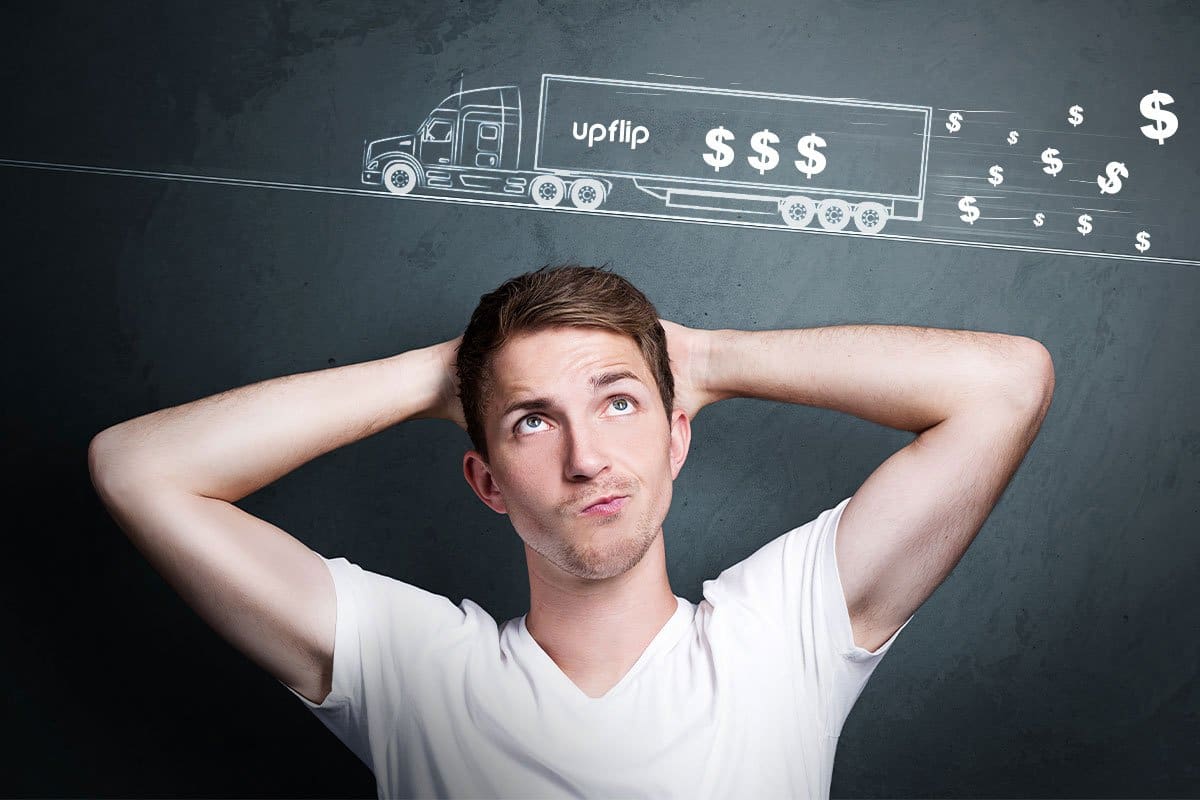
Yes, owning a trucking company can be highly profitable. The average trucker makes around $54K per year in wages and another $6,000 in profits, assuming they meet industry averages.
Mikael currently makes over $135K per year. He only drives in case of emergencies and pays his drivers to do most of the driving. So it can be highly profitable to start a trucking company without driving consistently.
New trucking businesses
More and more truckers choose to go out on their own once they have gotten some experience. In fact, owner-operators have the highest rate of solo entrepreneurs in the United States.
That’s because they can make a great living. Assuming the 4.2% rent is helping pay off their homes, that means the average business owner is paying off around $17,000 of their mortgage as a business expense.
Follow Commercial Truck Regulations
When you start a trucking company, it is important to understand you are entering one of the most regulated industries in the United States. If you provide long haul services, you’ll need to register with multiple agencies including:
- Department of Transportation
- Department of Labor
- State Agencies (in every state you operate in)
Mikael told us:
He also told us:
All of these costs add up, of course. Let’s have a look at the hard numbers so there are no surprises when you start to pay your startup expenses.
How much does it cost to start a trucking business?

You’ll want at least $50K-$60K to start a trucking company. Mikael explained the startup costs for a trucking company, which include the following:
- Truck: $32,000 (10 years or newer)
- Refurbished Trailer: $9,500 (currently worth $30K)
- Repairs: $6,000
- Fuel: $2,000 (first week)
- Insurance: $4,500 (down payment and first month)
- Permit: $950 per truck
- IFTA: $2,800 to get cross-country license plates
- Total: $57,750
The good news is:
How to start a trucking company with no money
Yes, many major transportation businesses offer company drivers the ability to transition to owner-operators after working with them for a certain amount of time. They do this by setting up brokerages, leasing companies, and load boards.
The leasing company leases the owner-operator a truck in exchange for the truck company owner committing to a multi-year contract with them. At the end of the contract, you have your own trucking company and truck owned outright.
We’ll discuss the leases more in later sections, but first let’s check out more resources to learn how to start a trucking company.
More resources for trucking businesses

There are industry organizations that you’ll want to follow to stay up to date on the trucking industry. These are some of the biggest in the U.S.
- American Trucking Association (ATA): The ATA is the largest group that collects industry data, lobbies for the industry, and provides info for trucking companies, moving companies, suppliers, and companies that need shipping.
- Transport Topics: This group publishes a variety of information about the industry including a Top 100 For-Hire list. FYI you need to make $244 million or more to be in the top 100.
- US Environmental Protection Agency (EPA): The EPA is tasked with regulating environmental concerns. Remember to pay attention to their rules involving trucking and agriculture because most trucking companies will be impacted.
- US Energy Information Administration (EIA): Be sure to pay attention to the transportation reports from the EIA if you haul oil and refined products.
- America’s Independent Truckers’ Association Inc. (AITA): Larry Daniel started AITA in 1997 to give independent truckers the same purchasing power as major conglomerates. It’s $10 per year for membership or $180 for fleets. If you find better discounts anywhere, they ask you to gather as much information as possible and send it to them so they can secure the same deal for all.
Step 2. Starting a Trucking Company Business Plan

As the saying goes, if you fail to plan, you plan to fail. You need a solid business plan. Trucking company business operations comply with numerous regulatory agencies. Your truck company business plan should address all aspects of the business that are essential to your success.
The business plan dictates the plan of action. Once you have some knowledge and experience in the trucking industry, writing your new trucking company’s business plan is the next logical step.
Your business plan is your venture’s founding document, and it will be the reference point for all business decisions moving forward. You want to put time and effort into composing the business plan because a well-written one will help improve the probability of business success.
Luckily, there are great resources for entrepreneurs who are writing their own business plans. Check out our business plan template and watch our interview with Mike Andes below.
The Small Business Association (SBA) is part of the federal government and provides a step-by-step guide to writing your business plan.
Truckstop.com also has a guide to writing a business plan for trucking companies.
Keep reading to learn how to identify the target market for your own trucking company.
Identify the target market

Your target market will mostly be businesses when you open your new trucking company. Depending on the type of truck, you might want to build relationships with different kinds of businesses. Some businesses that consistently need truckers include:
- Distributors
- Car manufacturers
- Agricultural businesses
- Marijuana growing facilities
- Moving companies
- Car dealerships
You’ll want to build relationships with load boards and brokers like datboard and truckstop.com, but Mikael also wins a lot of business with word of mouth recommendations. You’ll probably also want to consider seasonal fluctuations. Mikael told us:
It can be hard to describe your market accurately, but it’s a critical assessment to make. Market research firms gather data that are good for validating your original research. It’s worth considering hiring one if you aren’t confident in your research methods.ur original research. It’s worth considering hiring one if you aren’t confident in your research methods.
You can find a guide to market research for new businesses at Entrepreneur, and Joe Gardiner, CEO of VentureDevs, has a complete guide to market research at Forbes.
Define your business structure

Because of the investment, you’ll probably start a trucking business as a Limited Liability Company (LLC). A trucking LLC filing as an S-Corporation is the prevailing business structure when someone starts a trucking company.
Limited Liability Companies can opt for the business entity to be treated as an S-Corp for tax purposes. You just have to file an 1120-S with the Internal Revenue Service.
A successful trucking company will find this business entity and tax structure beneficial because they will be able to:
- Pay themselves a salary.
- Receive various personal liability protections.
- Separate business and personal assets.
- Save money on taxable income over $200,000.
Running your business in this method provides a good balance of liability protection and business structure if you choose to grow beyond a solo entrepreneur. Almost every successful trucking business will use either this structure or a C-Corporation.
You might want to hire a law firm to form your corporation because it’s easier to head off any problems as the business is formed rather than to go back and change your founding documents or business protocols once issues arise.
Check out our business hub for more in-depth information on business licenses and entities. Alternatively, review the Small Business Administration startup guide for more information.
Choose your trucking business name

Your trucking name can reflect your geographic origins, or it can be more abstract, or even the name of the founder. Sant Lines uses Mikael’s last name.
Choosing your trucking name is an important consideration that can affect both the present and future of your business.
For example, naming your company the Trucking Business of North Carolina may attract customers in your home state that want to do business with local trucking companies, but it might hinder your expansion outside of your state.
For some help with choosing a name for your business, check out our guide and business name generator. Alternatively, Forbes has a guide, as does The Balance.
Once you’ve determined your trucking name, run searches at your Secretary of State’s website and get a domain name from sites like GoDaddy or NameCheap.
Address start-up and operations costs
Your plan should outline the source(s) of your capital plus how and when investors will be paid back. Outline your operational costs carefully. For a trucking company, there are three main sources of operations costs:
1. Purchases
The primary costs associated with trucking are purchases including gas, maintenance, and repairs. These will be nearly ⅓ of your business expenses, so make sure to calculate them effectively. That means if you are doing long haul trucking, you should assume $153,667 of purchases per truck each year.
2. Wages
Your wages and any employee wages will be up to 29% of the revenue. That means you should assume you’ll be paying up to $133,690 if you are making the average amount for a long haul trucker. On average wages are around $55,000 per year across the industry.
3. Miscellaneous
The third largest expense relates to other costs like technology, miscellaneous business expenses, and taxes. These account for approximately 25% of revenue. I have created an automated 10 year calculator that estimates the revenue, expenses, and profits when considering the compound annual growth rate (CAGR) and how many trucks you want to add each year. Feel free to download it and try it out.
How much does a trucking owner make?
An owner-operator will normally pay themselves a salary plus profits paid out as either a dividend or return of capital. If you run as a sole operator, you need to make sure you set your pay correctly. There are a few ways you might fall under on the Bureau of Labor Statistics site:
1. Heavy Truck Driver: $51,790
2. Operations Manager: $106,630
3. Top Executives: $109,880
4. Chief Executives: $198,610
In addition, an average trucking company would offer around $20,000–30,000 in profits which can be treated as dividends. If you pay yourself less than the $106K salary, which I suspect most would for the first few years, do not give yourself more than a $30K dividend check unless you want to risk an audit.e trucking company would offer around $20,000–30,000 in profits which can be treated as dividends. If you pay yourself less than the $106K salary, which I suspect most would for the first few years, do not give yourself more than a $30K dividend check unless you want to risk an audit.
(I’m not a tax attorney, but I know enough that you don’t want to deal with IRS audits. If you make enough to pay yourself $200K, it is the safest bet.)
Consult a corporate attorney to get legal advice.
Step 3. Secure Startup Funding

Once you’ve put together a plan, it’s time to start considering how to secure startup funding. As Mikael stated, you’ll need around $50K to $60K just to make it through the first couple of months. If you factor in the first year, you’ll need almost $300K, and to make it through the first five years you can expect to need over $2 million. These numbers do not include wages or depreciation (because depreciation is not a hard cost).
Most business owners start their trucking company with personal savings or by borrowing from friends and family, but you can also qualify for equipment financing and other loans that use the truck to back the loan. We suggest reaching out to National Business Capital first because they offer flexible financing options and work with you to find the best loan for your business from over 75 lenders.
Crowdfunding
If your business will serve a particular community or industry, you might be able to use crowdfunding to get the startup costs. Of course, you’ll normally have to offer them something like discounted pricing or a free local delivery depending on how much they contribute.
Kickstarter is a popular site for business funding. If you’d like to learn more about the Kickstarter process, check out our interview with Pooch Selfie’s founder.
Major fleet owner-operator lease programs
While talking with one of my relatives about how to get into the trucking industry, he advised going through one of the major fleets to get financing. The way they work is they basically finance the truck in exchange for a contract of five years. After those five years, you own the truck.
He warned that you need to be cautious with these, however. Some of the fleets are a bit shady. If you are making less than $400 per day, they aren’t doing right by you. In addition, after five years you should absolutely own the vehicle. Make sure to read the contract carefully.
I asked about the best ones. He specifically mentioned:
- Knight Transportation (From Arizona)
- Werner Enterprises (Based in Nebraska)
- Schneider (Based in Wisconsin)
Step 4. Is a Trucking Business Hard to Start?

A trucking business isn’t hard to start, but you will have some unique requirements that most business owners do not.
First, you’ll need to get your commercial driver’s license (CDL). You’ll also need to perform the following tasks when you start a trucking company:
- Get your CDL.
- Get a truck and trailer.
- Submit IFTA Form 290.
- Apply for insurance.
- Register with the federal Department of Transportation (DOT).
- Join the International Fuel Tax Alliance.
- Get an IRP plate.
- Let’s look at the considerations.
Get Your Commercial Driver’s License
To drive a semi-truck, you’ll need a commercial driver’s license. Each state has different requirements, but most consist of the following:
- Be of good health based on hearing and response times, but there are other reasons you might not qualify.
- Pass background and driver safety checks.
- Get your state CDL manual from the Department of Motor Vehicles. Some states use alternate names.
- Take a commercial permit knowledge test.
- Go to a third-party commercial driving school. The manual should list licensed schools.
- Take the driver test.
Mikael told us:
He suggested JJ Keller for the school.
Next, you’ll want to apply for insurance because many of the following steps require it.
Buy A Truck

Mikael spent a good bit of time talking about the important aspects of a truck. He normally looks for vehicles with these features:
- Age: Under 10 years old
- Mileage: Under 750,000 miles
- Brands: Kenworth, Volvo, Peterbilt, Freightliner, Western Star
- Features: Sleeper included for long haul trips
- Market Price: Should be market price or slightly below to get the best value
He told us:
He also suggested bringing someone with you that can check the engine and transmission. They will be able to provide reasonable estimates for the cost of repairs and help you negotiate the price.
Types of Trucks
Trucks in the United States are rated by the gross vehicle weight rating (GVWR). The GVWR is a rating that manufacturers use to specify the maximum weight that a vehicle can operate safely. This weight includes the truck, trailer, gas, occupants, and freight. There are eight basic levels including:
- Passenger vehicles (light duty): Classes 1, 2a, and 2b have a GVWR of under 10,000 pounds. These also include popular trucks and SUVs like the Ford F150 and some box trucks.
- Medium duty vehicles: These go in Classes 3-6, which are below the 26,000 pound GVWR. Common vehicles in this class include Ford F350 to F650, Silverado 3500 to 6500, and Ram 3500 to 5500. A box truck company will fall in this category as well as some smaller semi-trucks with sleepers.
- Heavy duty trucks: Class 7 is 26,001 to 33,000 pounds, and Class 8 is over 33,000 pounds. These are the big boys, and they require a CDL.
The federal government requires heavy-duty trucks to have a commercial driver’s license, but each state has its own policies. California requires any vehicle over 6,000 pounds and 3 axles to have a CDL.
Tow trucks and other vehicles may also require CDLs. To learn more about tow truck driving, check out our interview with K.O. Towing below:
Types of Trailers
There are a ton of different trailers you can use for trucking. It just depends on what you need to carry. Some of the most common are:
- Dry Van Trailers: Standard trailers are 53 feet long and around 45,000 pounds maximum weight.
- Standard Flatbed Trailers: These trailers are great for products that don’t need to be protected from the elements.
- Refrigerated Trailers (Reefers): If you transport food, you’ll need temperature control with a max weight of 42,000–45,000 pounds.
- Drop-Deck, Step-Deck Trailers: These are similar to flatbeds but prevent height problems, and are up to 53 feet long.
- Double Drop, Lowboy Trailers: Double Drops are higher at the front and the back and carry 40K–80K pounds.
- Hotshot Trailers: This low-lying flatbed is 30–40 feet long, but only carries 16,500 pounds and is usable with Class 3 to 6 trucks.
- Conestoga Trailers: If you need a flatbed with a sliding tarp cover, use a Conestoga trailer.
- Curtainside Trailers: Need a dry-van with a solid front, top, and back, but tarp curtain sides to make it easier to load from the side? Curtain Trailers are the answer.
- Extendable Drop-Deck Trailers: These drop decks are built for lengths longer than 53 feet.
- Removable Gooseneck (RGN) Trailers: Use these to drive vehicles onto the trailer.
- Extendable RGN Trailers: These RGN trailers extend based on the length of your load.
Watch the video below to learn more about these trailers:
They don’t mention tankers in the video. You can transport hazardous waste or oil products, but those will require specialized licensing and knowledge. You are better off getting some miles on the road before you start hauling these products.
When first starting, you’ll probably only be able to choose one type of trailer. I’d probably go with a reefer or drop deck as they will offer you the most versatility. That sounds consistent with what Mikael told us:
- Refrigeration and frozen food (best in summer and fall)
- Flatbed for construction (springtime does best)
- Power only: Amazon is the biggest customer I have just ’cause of their volume
- Towing: I’ve delivered as far as Nevada
Fill out Form 2290
You’ll need to pay your heavy use taxes to the IRS before you can start driving. You’ll use Form 2290 and either apply for an exemption or pay up to $504.17 (subject to increase). You won’t be able to get your authority or IRP License without proof.
Get your trucking insurance
You’ll need active insurance coverage including public liability insurance. The requirements vary based on state and federal laws, but you will need at least $750,000 of Bodily Injury (BI) and Property Damage (PD) liability insurance coverage. If you will be transporting hazardous materials, the requirement is $5 million.
The ATA has an agreement with Sentry as a preferred insurance provider. Most major insurers also have a commercial truck insurance product, or you can also find specialized truck insurance from companies like Owner Operator Direct.
Become a trucking authority
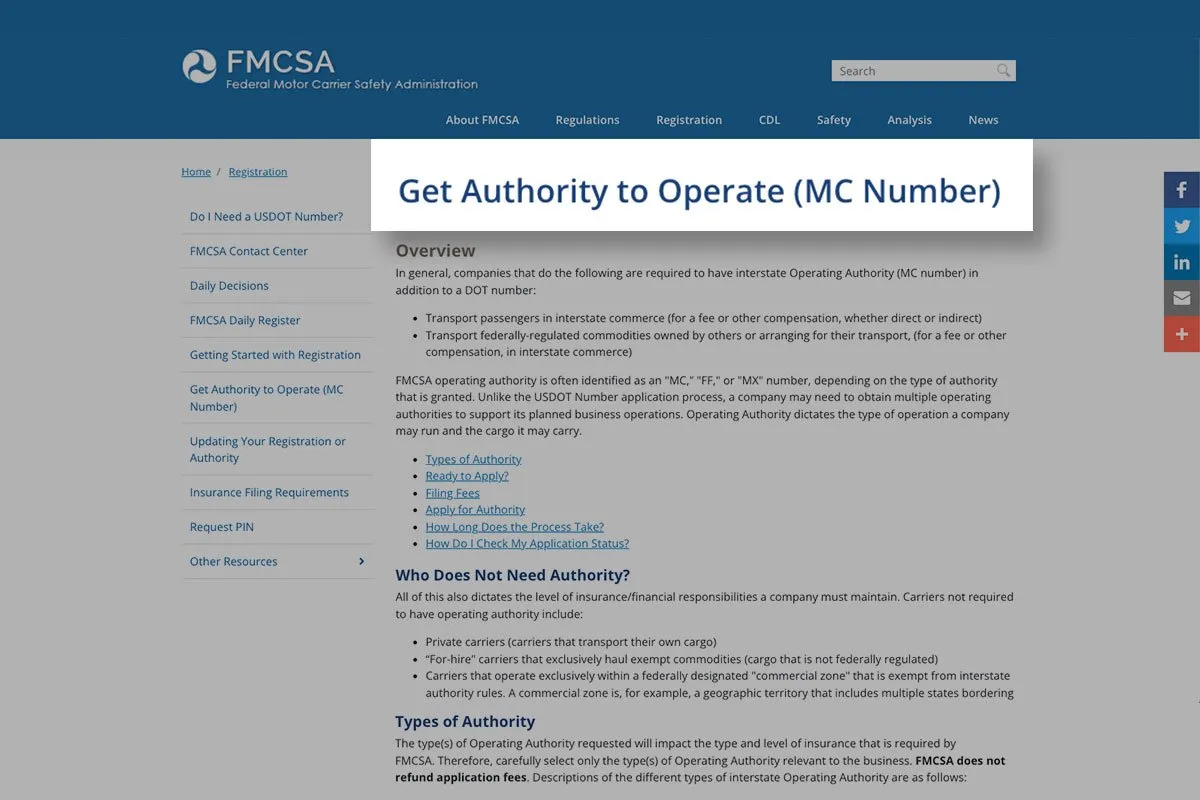
To run an interstate (operating across state lines) business in the U.S. transportation industry, you will need to get licensed as an operating authority with the Federal Motor Carrier Safety Administration (FMCSA). To apply, you’ll need to:
- Get your Department of Transportation (DOT) number here.
- Get the proper insurance.
- Apply for the Operating Authorities you wish to qualify under. There are multiple types.
- Pay $300 fee per Operating Authority.
When you perform these steps you will have a temporary operating authority for your self-owned trucking company. The DOT has to perform an audit before you have a permanent operating authority. These are not actually permanent, however, as they will take it away if you do not operate under the laws.
Join International Fuel Tax Association (IFTA)
You’ll want to join the International Fuel Tax Association. It was created under the International Fuel Tax Agreement to simplify the payment of fuel taxes in the continental United States, Alaska, and Canadian provinces.
Truckers are required to pay fuel tax based on the percentage of miles they drive in each state. To simplify the administrative costs, each jurisdiction handles its own member applications, tax returns, and audits. Read up on how it works on the IFTACH website.
You’ll need to apply at your local office and pay a fee which will provide you with two decals to prove your membership.
These taxes fund highway programs that you and other trucking companies rely on to transport products, livestock, and agricultural goods.

You can get more details on the IFTA website.
You’ll need to file a tax return every year for your gas tax. Fortunately, you just file with your state and they’ll distribute it accordingly. You’ll need to track your miles and time in each state to pay the appropriate taxes whether you bought gas in that state or not. You can use a log book or an electronic log (elog). I talked to a relative that is a truck driver and he warned:
Get an IRP plate
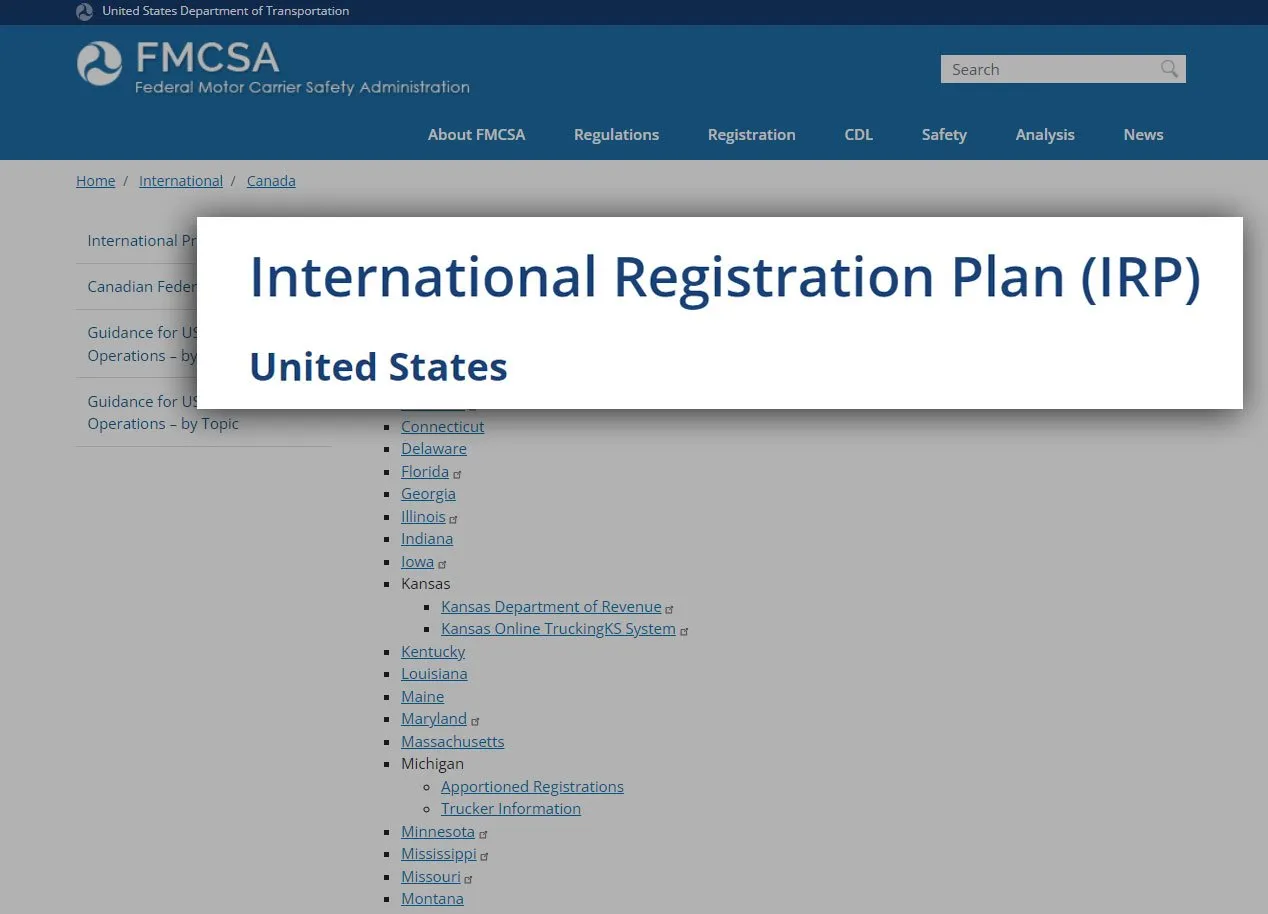
You’ll need an International Registration Plan (IRP) before you start a trucking company. An IRP is a plate that allows you to get plates that work in all states. You’ll want to go to the appropriate licensing office in your state to get these. You can find each state in the FMCSA list of providers.
Some states also require additional permits to operate within them. Mikael told us:
Allow a DOT Trucking company audit
When you start a trucking company, the DOT will conduct an audit during the first year to verify that:
- You are keeping proper records.
- You have a drug and alcohol testing program.
- All insurance is up to date.
- Periodic inspections are performed and documented.
- No major infractions incur.
You can learn more at FMCSA. If you do not pass this audit, your business will not get permanent authority to operate.
Keep reading for tips on how a successful trucking company gets customers.
Step 5. Get Customers

With all the regulatory compliance that starting a trucking involves, it’s easy to lose sight of the end goal of any business: attracting and retaining new customers.
Getting customers for your new trucking business isn’t that hard these days. There is a huge shortage of drivers, and you just have to get your name out there.
Mikael had a ton to say about finding customers. He told us:
Create your brand
One of the best ways to attract new customers is by creating a memorable brand image through an effective branding campaign.
Branding is the process through which a company’s mission, values, and image enters the public consciousness.
Get a good logo
Successful branding begins with a good logo that represents the company effectively and in a simple, easily memorable manner.
Getting the logo right is an important step toward corporate success, and if you are not a natural artist or computer graphics expert, plenty of firms offer logo design for reasonable rates. It’s a worthy investment of resources toward a bright future for your new trucking business.
Advertise your brand on social media
Successful advertising happens in both traditional and social media. Mikael told us:
He went on to explain that he does short videos to help people understand the industry better. He even hires new drivers through the videos. He had four interviews from a single TikTok video.
Determine your competitive advantage
Branding and advertising can all be for naught if your company’s competitive advantage is not clearly defined. A competitive advantage is a unique service, perk, or reward that differentiates your business from others.
The trucking business is a very competitive industry with some large players that have thousands of trucks in their fleet and nearly half a million competitors. Some ways to differentiate your trucking company might be:
- Subscription-based models: Charge customers monthly for a guaranteed number of miles or pounds. Mikael has several customers that have a consistent pickup day and time. He’s able to reduce the administrative time and cost for them because they just routinely send their order.
- Service-based models: Guarantee on-time pickup and delivery (better follow through).
- Pricing: Offer premium service or discount service. For instance, you might give someone a discount if they have a delivery that you can just add onto your current load.
- Be more open: Mikael told us that different industries pay better at different times of the year. Share how you calculate pricing so people can create their own estimate and request a pickup.
Don’t neglect traditional marketing
Mikael reminded us that traditional marketing strategies like business cards and networking are really beneficial in the trucking industry. He told us that the trucking industry is in demand by most companies.
Always be prepared; you never know where you’ll find customers.
Links to resources about business marketing

There are a couple of excellent articles that focus specifically on getting customers. Forbes offers ten ways to get customers to your new small business, and Inc. offers the same, with a focus on also increasing your sales.
Step 6. Manage Your Trucking Business Finances
Mikael runs multiple businesses so he had a lot to say about how to manage a trucking business (or any business for that matter). Some of the advice he gave us included:
- Get a business bank account with a credit union.
- Make sure you have at least a personal credit score of 680.
- Be sure to have at least $10K down payment if you’re financing the business.
- Always have money for incidentals. (His company had 2 flat tires in a week and 16 repairs in a month.)
- Use Quickbooks and hire a bookkeeper.
He told us:
He went on to explain how they try to grow. He explained:
Step 7. Trucking Companies Need Admins

Trucking companies have a lot of administrative work they have to do. If you’re a solo entrepreneur, you’ll be doing it yourself, or you can hire people to help you. A lot of truckers hire their wives to do the dispatch. This can be a good or bad thing. Make sure she understands what she’s doing.
The main administrative work is typically done by dispatchers. A dispatcher will normally make between $30,000 and $75,000 per year and have job responsibilities including:
- Providing estimates to customers
- Preparing dispatch documents
- Planning and adjusting routes
- Scheduling driver pickup and delivery times
- Communicating with customers about delivery or pickup times, freight limitations, and special requests
- Creating bills and invoices
- Maintaining call records, delivery and pickup times, driver routes, and route changes
- Updating drivers on transportation regulations and laws
- Reviewing drivers’ logs and comparing them to quoted arrival times.
- Logging shipping schedules
- Monitoring truck repairs
- Scheduling maintenance
- Logging shipping schedules
- Managing complaints
You can outsource your dispatch to a company like Cameron.
You’ll probably need some software to manage this so let’s look at some of the software Mikael suggests.
Technology
Mikael suggested the following software:
- Motive: This software is a combination of risk management, security, and customer relationship tools. When used with the video cam, it is also good for an educational tool.
- DAT board: Use this to find a load that you can use to improve your returns by running a fuller truck and getting loads for the return home.
How to Start a Trucking Business Frequently Asked Questions
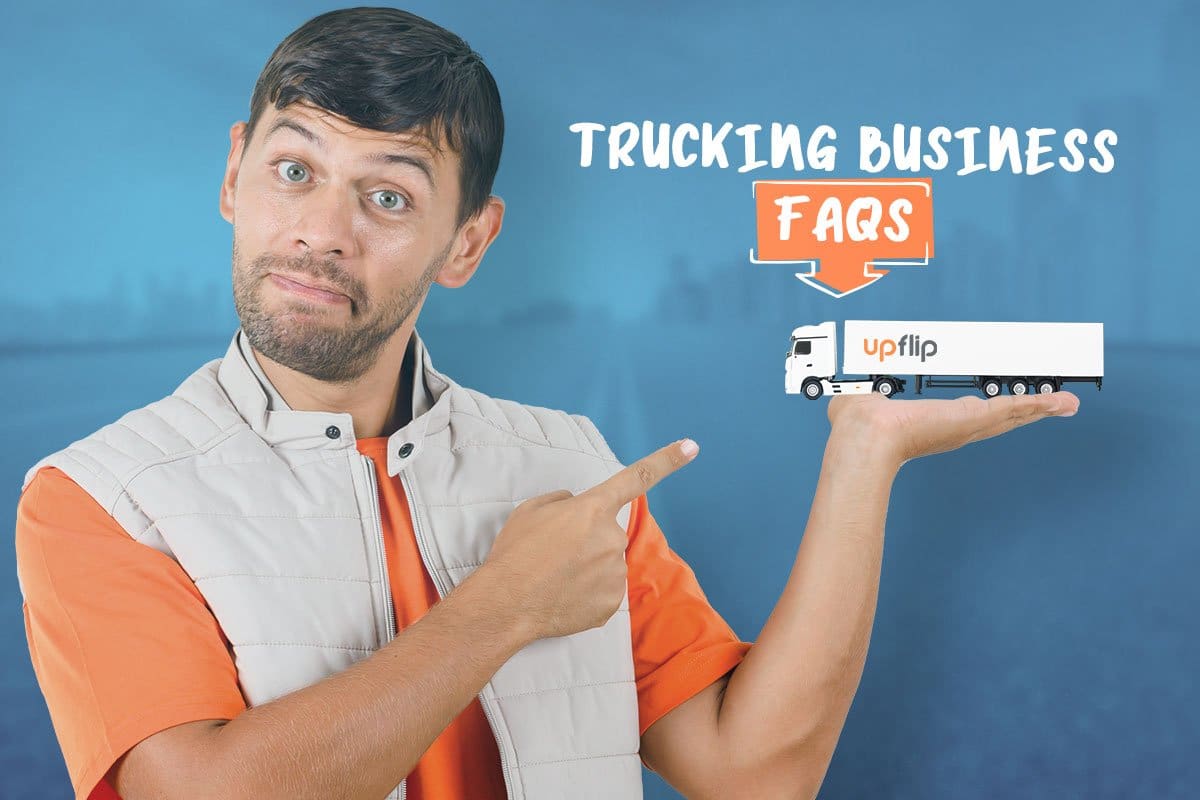
We’ll answer some of the most frequently asked questions on how to start a trucking company in this section so you are better prepared for your own trucking business.
How to start a trucking business with one truck
You can either start your own trucking company as an owner-operator or pay someone else to drive the truck. You’ll want to:
- Learn more about how to start a truck business.
- Write a business plan about how to start your own trucking company.
- Secure the funds for starting a trucking business.
- Go to a private truck driving school.
- Go through the entire regulatory process. We explain it more if you go to Step 4 in the blog.
- Find customers.
- Manage your company.
- Hire administrative help.
- Pay your taxes.
How to start a trucking business owner-operator
An owner-operator will be required to perform all parts of a successful business. You’ll need to:
- Get all business license requirements.
- Comply with government regulations.
- Maintain business insurance.
- Establish contracts.
- Manage cash flow and fuel costs.
- Haul loads.
- File IFTA’s quarterly tax returns.
- Maintain new or used trucks.
We created an owner-operator startup checklist for those who want more information on how to start a owner-operator trucking business. Download it below.
How to start a box truck business

Starting a box truck business is a little bit easier than other trucking companies. You’ll want to:
- Check if you need a CDL in your state and surrounding states. Get it if you need it.
- Start your LLC or Corporation.
- Get your state and local business licenses.
- Get a business bank account.
- Get your commercial driving and business insurance.
- Find customers.
- Transport loads.
- Manage the finances.
Be sure to glance back at the steps included in this article if you have questions about these tasks.
Most box trucking companies are not required to have the following:
- International Registration Plan plates
- International Fuel Tax Agreement decals
- DOT registration
- Unified Carrier Registration
How to start a trucking brokerage business
A truck broker or freight broker is a company that has relationships with suppliers and transportation companies. They manage a load board and help both parties meet their unique business needs. They may be large businesses that also participate in hauling loads, or they may be strictly middlemen.
To start this type of company, you will need to follow the 7 steps outlined above, including:
- Understand how to start a trucking business.
- Write a business plan.
- Secure funding.
- Go through the legal proceeding requirements.
- Get customers.
- Manage your trucking finances.
- Handle administration. This section will be particularly important to a broker.
Read the whole blog for more information on how to start trucking business brokerages.
How to start a trucking business without driving

There are a few ways to start a trucking business without driving. Some of the trucking businesses that don’t require you to drive include:
- Freight factoring company: Provide loans on invoices for a percentage of the load.
- Freight brokerage: Develop relationships with shippers and truckers and play the middleman. You still need all the requirements of a trucking company, though.
- Process Agent: A process agent is a company that has a person and office in every state. They are necessary under the Unified Carrier Registration. You can find a full list on the FMCSA.
- Trucking Software Provider: If you think you can find ways to help truckers simplify reporting, financial projections, taxation methods, or other essential parts of their job, you might have a great opportunity because the industry is in constant flux.
- Hire drivers with CDLs: You can start a trucking business without a CDL, but you’ll have to pay truckers to haul the loads for you. Mikael operates in this manner but still has his CDL just in case something happens.
Who are good trucking influencers to follow on social media?
Checking out what other companies are doing can be really beneficial. Part Catalog has a great list of trucking influencers. We included two with the highest engagement and Mikael Sant’s links.
- Alex the Trucking Guy: YouTube / Instagram
- Big Rig Barbie: YouTube / Instagram
- Mikael Sant: TikTok / Podcast
So What’s The Best Trucking Business to Start?
Starting a trucking company requires complying with a lot of regulations, a lot of administrative functions, and a lot of patience and determination to build a company that makes more than $75K per month. It’s achievable, though.
Just make sure it works with your life. While long-haul trucking is more profitable, you might want to start locally if you have a family you want to see every night.
Given the amount of regulation, starting a truck company might not be the first business you start unless you’re already driving and want to go independent. You can definitely build a successful career in trucking, but it’s a long haul.
For those who successfully scale the formidable barriers to entry, the financial rewards can be great. But the majority of trucking owners love the freedom of the open road and are typically mom-and-pop shops.
Do you have experience running a trucking business? What do you love about it? What would you change? With what other businesses do you get to explore the world as you work?

